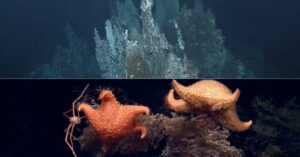
Dubai Launches Trial Operation For World’s First Electric 3D-Printed Abra
July 16, 2024
CIMAC Granted Consultative Status By IMO, Aims To Enhance Maritime Industry’s Digitalization & Innovation
July 17, 2024

The Government of Canada, in collaboration with coastal First Nations, has designated Tang.ɢwan — ḥačxwiqak — Tsig̱is as Canada’s largest Marine Protected Area (MPA) under the Oceans Act.
This vast territory, located approximately 150 kilometers off the west coast of Vancouver Island, spans 133,017 square kilometers and is an essential spot for Canadian marine conservation activities.
The Tang.ɢwan — ḥačxwiqak — Tsig̱is MPA has unique deep-sea features, including over 47 underwater mountains and all documented hydrothermal vents in Canada.
These ecologically diverse “hotspots” are home to uncommon deep-water species that are essential to local biodiversity and have cultural significance for the participating First Nations.
The initial efforts to safeguard this region began in 2017 when it was designated as a Conservation area of Interest.
Subsequent measures, including fishing restrictions, culminated in its formal designation as an MPA, which was confirmed by a Memorandum of Understanding signed in 2023 by the Council of the Haida Nation, Nuu-chah-nulth Tribal Council, Pacheedaht First Nation, Quatsino First Nation, and the Canadian government.
Today, the large ecologically unique ocean area Tang.ɢwan — ḥačxwiqak — Tsig̱is was designated as a #MarineProtectedArea (MPA). https://t.co/RIdFGZFGxT pic.twitter.com/wcWkhJUnuJ
— DFO Pacific (@DFO_Pacific) July 11, 2024
Video Credits: DFO Pacific/X
The MOU’s collaborative management strategy focuses on cooperative stewardship and preservation activities, emphasizing commitments to both maritime protection and reconciliation.
Each partner First Nation has also undertaken its designation processes, emphasizing the importance of Indigenous governance within Canada’s conservation framework.
The Honourable Diane Lebouthillier, Minister of Fisheries, Oceans, and the Canadian Coast Guard, expressed her confidence about the MPA’s significance, saying, that they are taking a major step forward in protecting Canada’s oceans.
The Tang.ɢwan — ḥačxwiqak — Tsig̱is MPA designation advances Canada’s goal of conserving 30% of its oceans by 2030, increasing the existing protection level from 14.66% to 15.54%.
In addition to its environmental benefits, the MPA’s name emphasizes its cultural value, integrating words from Haida, Nuu-chah-nulth, Pacheedaht, and Quatsino languages that represent the deep ocean and unique marine features.
This comprehensive approach to marine conservation not only protects crucial habitats, but also establishes a precedent for collaborative governance between Indigenous nations and the federal government, advancing reconciliation and environmental stewardship in Canada.
The Tang.ɢwan — ḥačxwiqak — Tsig̱is MPA’s new regulations, published in Canada Gazette Part II, formalize its protected status and ensure the preservation of this crucial marine ecosystem for generations to come.
Reference: canada.ca
Government Of Canada & Coastal First Nations Establish Canada’s Largest Marine Protected Area appeared first on Marine Insight – The Maritime Industry Guide
Source: Maritime Shipping News


